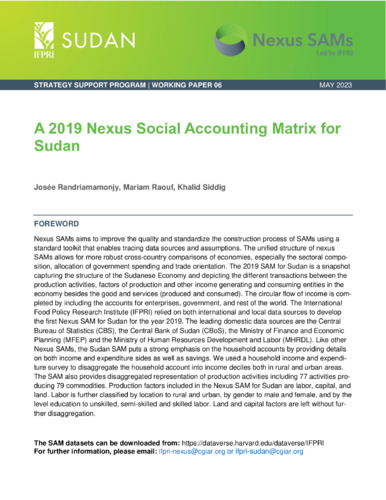A 2019 nexus social accounting matrix for Sudan
Abstract
Nexus SAMs aims to improve the quality and standardize the construction process of SAMs using a standard toolkit that enables tracing data sources and assumptions. The unified structure of nexus SAMs allows for more robust cross-country comparisons of economies, especially the sectoral composition, allocation of government spending and trade orientation. The 2019 SAM for Sudan is a snapshot capturing the structure of the Sudanese Economy and depicting the different transactions between the production activities, factors of production and other income generating and consuming entities in the economy besides the good and services (produced and consumed). The circular flow of income is completed by including the accounts for enterprises, government, and rest of the world. The International Food Policy Research Institute (IFPRI) relied on both international and local data sources to develop the first Nexus SAM for Sudan for the year 2019. The leading domestic data sources are the Central Bureau of Statistics (CBS), the Central Bank of Sudan (CBoS), the Ministry of Finance and Economic Planning (MFEP) and the Ministry of Human Resources Development and Labor (MHRDL). Like other Nexus SAMs, the Sudan SAM puts a strong emphasis on the household accounts by providing details on both income and expenditure sides as well as savings. We used a household income and expenditure survey to disaggregate the household account into income deciles both in rural and urban areas. The SAM also provides disaggregated representation of production activities including 77 activities producing 79 commodities. Production factors included in the Nexus SAM for Sudan are labor, capital, and land. Labor is further classified by location to rural and urban, by gender to male and female, and by the level education to unskilled, semi-skilled and skilled labor. Land and capital factors are left without further disaggregation.

